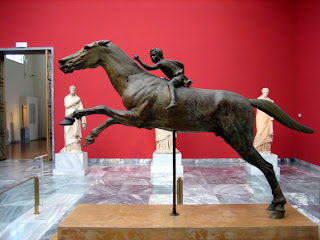ROMAN ART – EARLY EMPIRE
Ancient
Rome refers to the Roman civilization from the founding of the city of Rome by
Romulus in 753 BCE to the collapse of the Western Roman Empire in 476 CE.
Ancient Rome encompasses the Roman Kingdom, Roman Republic and Roman Empire
until the fall of the western empire. In 509 BCE, Rome became a republic but collapsed
in a civil war thus triggered the beginning of a new period. Roman Empire began
in 31 BCE when Octavian, the adopted son of Julius Caesar, defeated Cleopatra
and Mark Antony at the Battle of Actium and was granted overarching power and
the new title ‘Augustus’. The imperial period of Rome lasted approximately
1,500 years compared to the 500 years of the Republican era. The Roman Empire
was among the most powerful economic, cultural, political and military forces
in the world of its time. It was one of the largest empires in world history.
When
you think of Roman art, the Colosseum and the ruins of the Roman Forum
immediately spring to mind. You may also think of all the public sculpture that
decorated ancient Rome. Those are called public arts. These public works of art
functioned as political propaganda and advertised the accomplishments of the
emperor to all Romans. However, the emperor also commissioned small private
works of art such as gems, and cameos. Unlike art in the public sphere, only a
selected few would have been granted access to private arts. However, despite
the fact that private art would not have been seen by the majority of Roman
citizens, the messages contained within these works would have functioned in
much the same way as their public counterparts.
Gemma Augustea
37 -41 CE
Gemma
Augustea is an example of cameos. Typically cameos were made of a brown stone
that had bands or layers of white throughout, such as sardonyx. It is commonly agreed that the gem cutter who
created the Gemma Augustea was either Dioscurides or one of his disciples, in
the second or third decade of the 1st century CE. This layered
stone was then carved in such a way that the figures stood out in white relief
while the background remained the dark part of the stone. Most cameos were
small and functioned as pendants or rings. But there are a few examples of much
larger cameos that were specifically commissioned by the emperor and members of
his imperial circle; Gemma Augustea is one of it.
The
Gemma Augustea is divided into two registers that are crammed with figures and
iconography. The upper register contains three historical figures and a host of
deities and personifications. At the center of the upper register, there are
two large enthroned figures, Roma (the personification of the city of Rome) and
the emperor Augustus. What does the top register mean, with its grouping of
mortals, deities, and personifications? In short, everything praises Augustus.
The emperor expresses his domination throughout the Roman Empire and his
greatest accomplishment, the pacification of the Roman world, which resulted in
fertility and prosperity.
The
lower register is significantly smaller than the upper, but it nevertheless has
plenty of figures in its two scenes, both of which show captive barbarians and
victorious Romans. At the left, Roman soldiers raise a trophy while degraded
and humiliated barbarians sit at their feet. At the right is a similar scene,
showing barbarians being brought into submission by Roman soldiers. While the
upper register focuses on peace, the lower register represents the wars that
established and maintained peace throughout the Roman Empire.
So, even though the Gemma Augustea is a work of private art, the cameo nevertheless
offers a political message and thus serves a purpose similar to public art. The
Gemma proclaimed Augustus’s greatest accomplishment, the Pax Romana, his
military victories, his connections to the gods and his god-like status, and
his hopes for dynastic succession.




Comments
Post a Comment